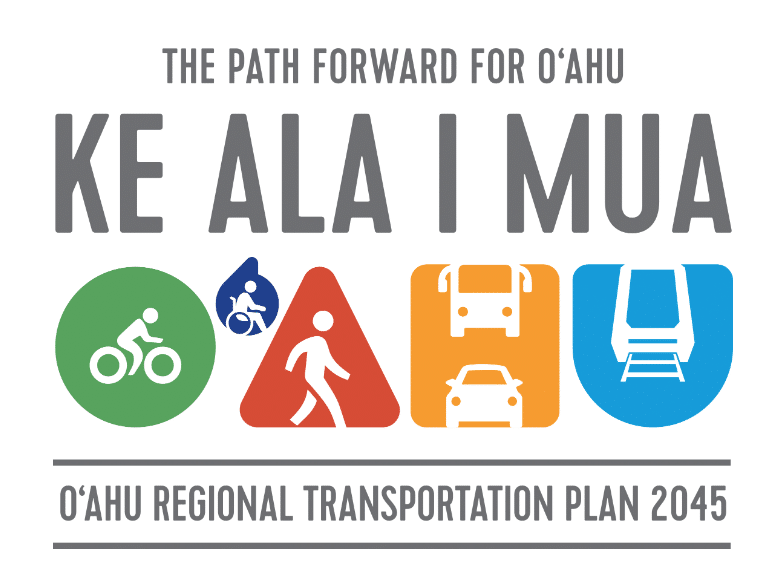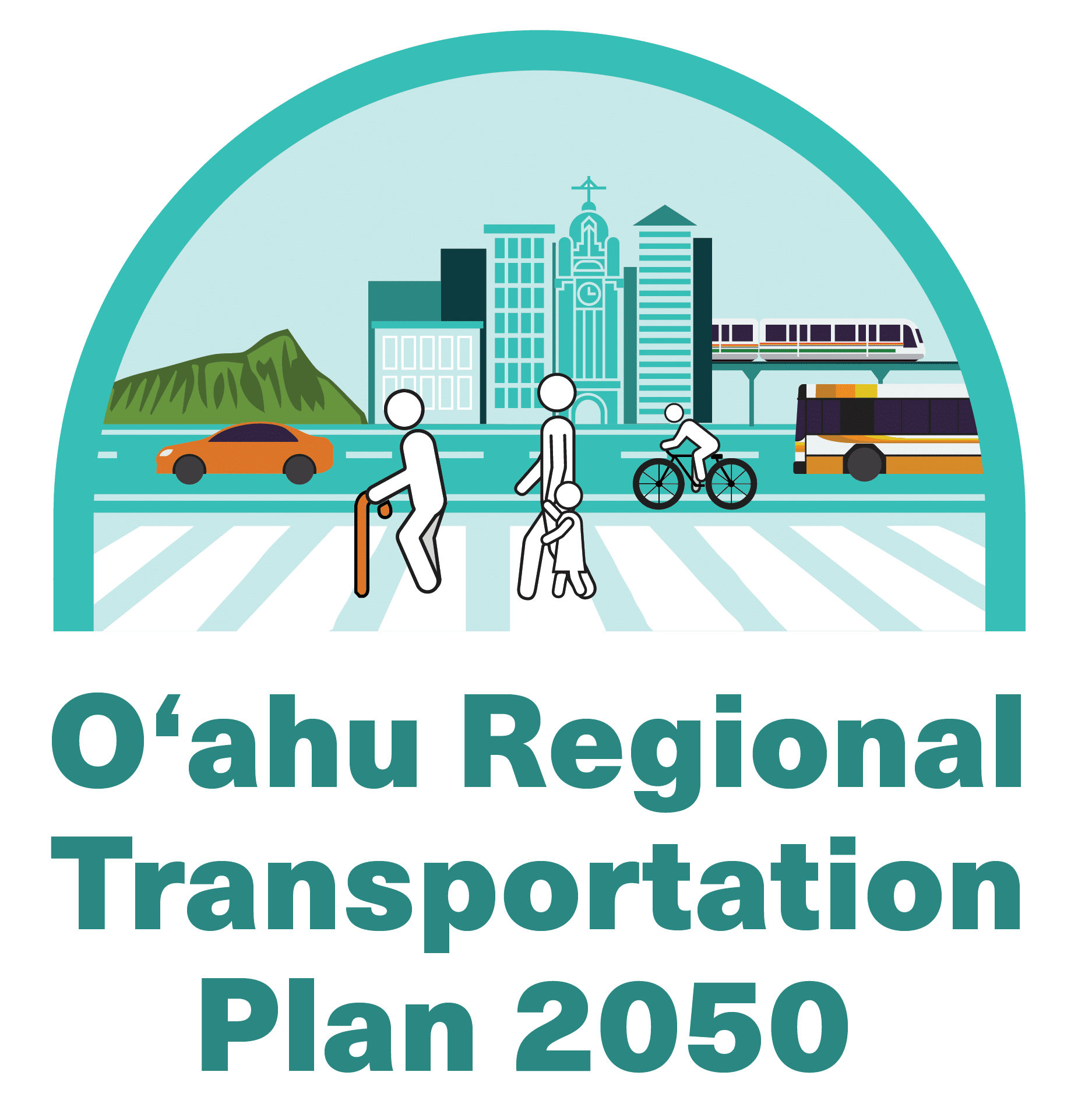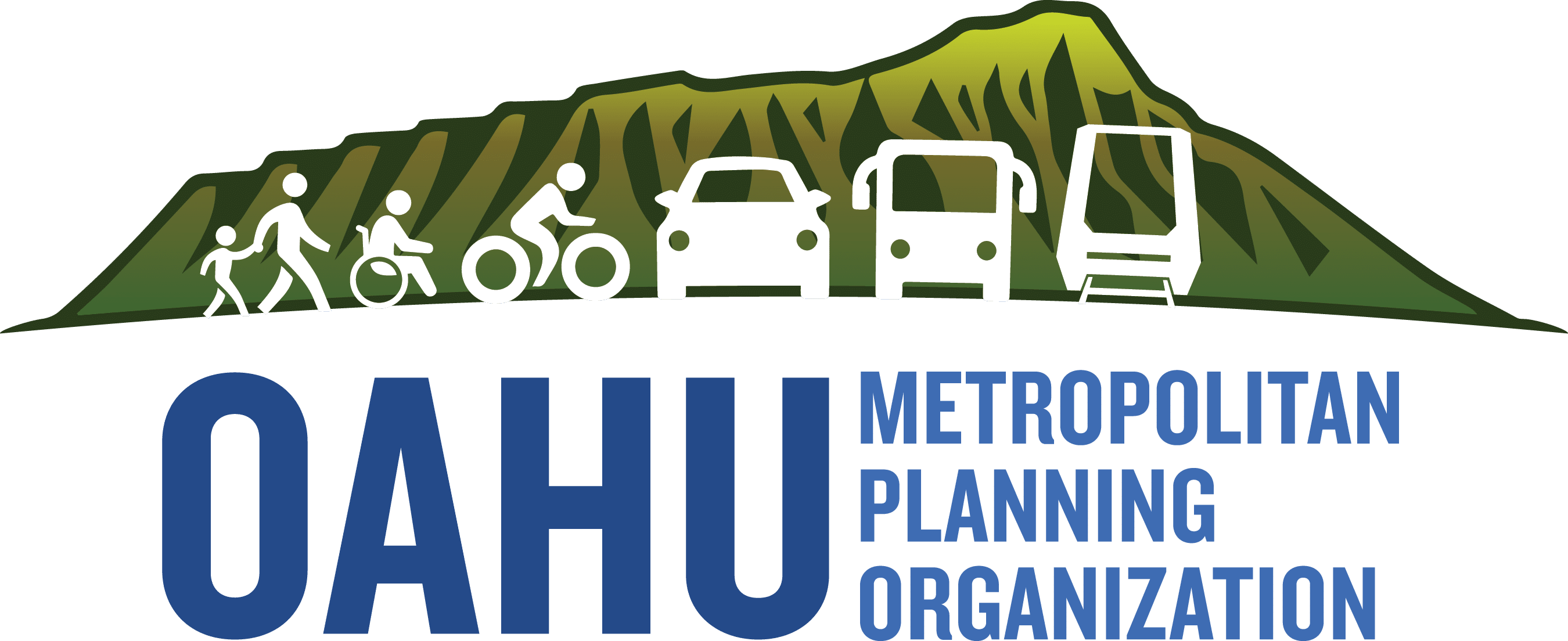Oahu Regional Transportation Plan
The Oahu Regional Transportation Plan (ORTP) outlines transportation goals, objectives, policies, and projects for Oahu. The 25-year horizon of the plan incorporates forecasted population, housing, employment, environmental, land-use, and technology changes. The ORTP identifies strategies and actions to promote the development of an integrated, inter-modal, surface transportation system that facilitates the safe, efficient, and economical movement of people and goods. It also identifies specific highway, transit, freight, bicycle, and pedestrian projects that are designed to improve safety, mitigate congestion, and increase mobility for Oahu’s residents and visitors. The ORTP is updated every five years, and the current plan is the ORTP 2045.
Please use the tabs below to navigate the different ORTP years.

ORTP 2045 Revisions
- Oahu Regional Transportation Plan 2045 Revision 1 (PDF)
- Oahu Regional Transportation Plan 2045 Revision 2 (PDF)
ORTP 2045
- Map of the Proposed Projects and Programs
- Appendix A: Intergovernmental and Public Review Comments Phase 3 (PDF)
- Appendix B: Public Involvement Summary and Evaluation (PDF)
- Appendix C: Transportation Revenue Forecast (PDF)
- Appendix D: Project and Program Prioritization Process (PDF)
- Appendix E: Project and Program Application (PDF)
- Appendix F: Project and Program Applications and Evaluation of New Projects and Programs (PDF)
- Appendix G: New Project Information Sheets (PDF)
- Appendix H: Public Comments on Initial Project and Program List Phase 2 (PDF)
- Appendix J: Title VI/Environmental Justice Analysis (PDF)

The Oahu Regional Transportation Plan 2050
Planning for the Oahu Regional Transportation Plan (ORTP) 2050 is currently underway! Please Contact Us to share your comments and feedback.
ORTP 2050 Goals, Objectives, and Performance Measures
Upcoming ORTP Events (Pending)
Oahu Regional Transportation Plan 2040
The Oahu Metropolitan Planning Organization (OahuMPO) Policy Board approved the Oahu Regional Transportation Plan (ORTP) 2040 on April 13, 2016.
Find the full ORTP 2040 here (PDF).
Find the list of projects included in the ORTP 2040 here (PDF).
Existing Conditions Online Survey Results here (PDF).
Oahu Regional Transportation Plan 2035
The OahuMPO Policy Board approved the ORTP 2035 in April 2011.
Find the full ORTP 2035 here (PDF).
Oahu Regional Transportation Plan 2030
The OahuMPO Policy Board approved Amendment #1 to the Oahu Regional Transportation Plan 2030 in May 2007. The Oahu Regional Transportation Plan 2030 was first approved in April 2006. The Plan was consistent with and met the requirements of the Safe, Accountable, Flexible, Efficient Transportation Equity Act: A Legacy for Users (SAFTEA-LU), which was adopted by the United States Congress in 2005. This plan incorporated the City and County of Honolulu’s fixed guideway project between East Kapolei and Ala Moana Center. The fiscally-constrained plan called for approximately $15.3 billion (in 2005 dollars) worth of projects.
Find the Oahu Regional Transportation Plan 2030 here (PDF).
Transportation for Oahu Plan TOP 2025
The Transportation for Oahu Plan TOP 2025 was developed in 2000 and endorsed by the OahuMPO Policy Committee in April 2001. It used a 2025 planning horizon year. Like many cities across the United States, the projects necessary to meet the congestion and transit needs of Oahu far exceeded the funding available. While over $7 billion (in year 2000 dollars) in projects were proposed, only $3.6 billion (in year 2000 dollars) worth of projects were included in the plan to meet the Federal requirement for financial constraint. New to the transportation planning series was a list of illustrative projects that could be considered if projects in the Transportation for Oahu Plan TOP 2025 list became infeasible or if additional funds became available.
Find the Transportation for Oahu Plan TOP 2025 here (PDF).
Find the accompanying errata sheet here (PDF).
Oahu Regional Transportation Plan 2020
The ORTP 2020 updated Hali 2005 and was the first iteration of the regional transportation plan developed after the Intermodal Surface Transportation Efficiency Act (ISTEA) was authorized by Congress in 1991. ISTEA established new transportation planning requirements for state and metropolitan jurisdictions, which included that the regional transportation plan have a time horizon of at least 20 years, contain a priority list of projects, be financially constrained, and include input from public officials and citizens. Among the 2020 ORTP list of projects were the construction of Interstate H-3, addition of lanes on Kahekili Highway, and other roadway improvements.
Hali 2005
Hali 2005 identified transportation plans and policies to address Oahu’s travel needs through the year 2005. The plan included highway, public transportation, transportation system management, and bicycle elements. The document described socioeconomic and travel forecasts for the year 2005, presented various elements of the plan, and included a financial analysis.
Hali 2000
Prepared in 1984, Hali 2000 analyzed the travel needs for the year 2000 and provided an assessment of alternative future transportation system approaches to serve those needs. The study included transportation system management, highway system, at-grade or partially grade-separated light rail, and a fully grade-separated rapid transit alternatives, in addition to a baseline scenario consisting of committed projects. Costs and impacts on various system performance and environmental measures were estimated for each alternative.
Digital copies prior to the Transportation for Oahu Plan TOP 2025 are not available online. Printed copies of these reports can be made available from the OahuMPO upon request for the cost of printing and postage.
